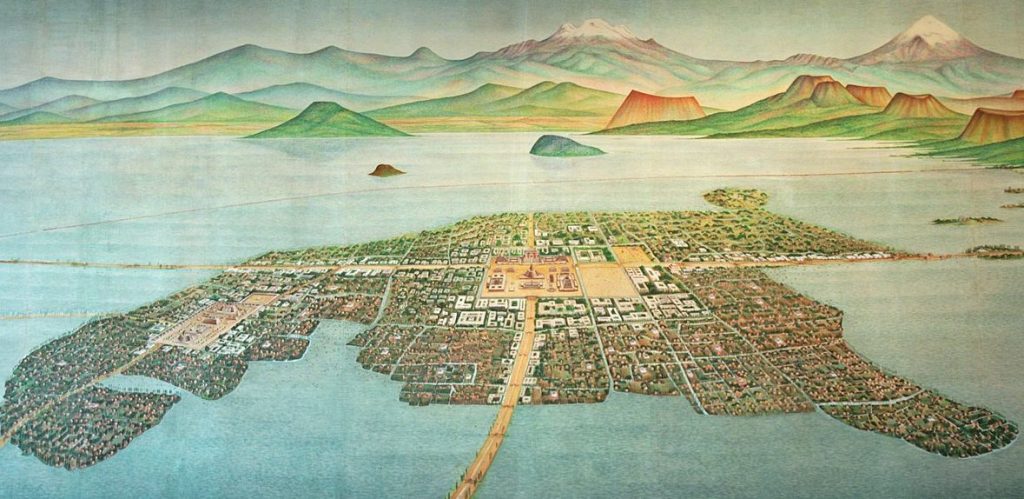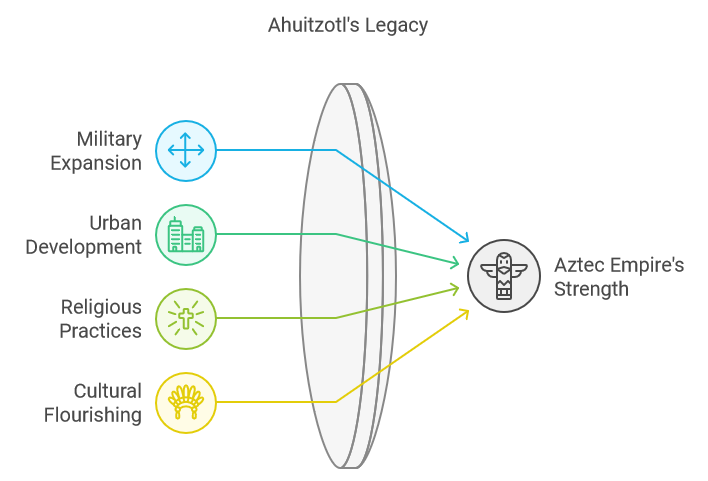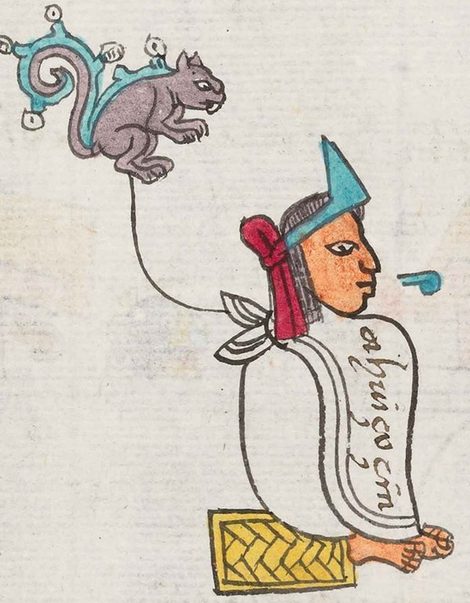Ahuitzotl stands out as one of the most influential rulers in the history of the Aztec Empire, presiding over a period of remarkable growth and transformation. His reign, from 1486 to 1502, was marked by ambitious military campaigns, extensive urban development, and a strong emphasis on religious practices. As a leader, Ahuitzotl not only expanded the empire’s territories but also left a lasting legacy that shaped the cultural and political landscape of Mesoamerica.
1. Military Expansion
Overview of Military Campaigns
Military conquests were central to the Aztec way of life, serving not only as a means to acquire land but also as a method for asserting dominance over neighboring tribes. Under Ahuitzotl’s leadership, the Aztec military undertook several aggressive campaigns, demonstrating their prowess and ambition.
Key Conquests
- Cholula
- Cholula was a major city known for its religious significance and large population, serving as a cultural and economic hub in central Mexico. The conquest of Cholula was particularly important for Ahuitzotl, as it not only expanded the empire’s territory but also established a critical foothold in a strategically significant area. The outcomes of this conquest included the integration of Cholula into the Aztec Empire, along with the collection of tribute and resources from its residents, further enriching the empire.
- Oaxaca
- Ahuitzotl’s campaigns in the Oaxaca region were marked by strategic military maneuvers that extended Aztec influence deep into southern Mexico. These military efforts were aimed at subduing rival states and securing resources essential for the empire’s sustenance. The successful campaigns in Oaxaca significantly bolstered the Aztec Empire’s southern borders, ensuring that vital trade routes remained under their control.
Impact of Military Expansion
The military expansion under Ahuitzotl had far-reaching implications for the Aztec Empire. With each conquest, the empire experienced a substantial increase in resources and tribute, which in turn enhanced its political power. This expansion not only solidified Ahuitzotl’s authority but also set the stage for the empire’s status as a dominant force in Mesoamerica, creating a legacy that would influence future generations.

2. Construction Projects
Urban Development in Tenochtitlan
Tenochtitlan, the capital of the Aztec Empire, was not only the political heart of the empire but also a symbol of its grandeur and cultural sophistication. Founded on an island in Lake Texcoco, Tenochtitlan was renowned for its intricate network of canals, bridges, and causeways that connected the city to the mainland. Under Ahuitzotl’s reign, the city experienced significant urban development, transforming it into one of the largest and most advanced cities in the world at the time. The city’s vibrant markets, elaborate temples, and thriving population made Tenochtitlan the center of Aztec civilization.
Key Projects
- Expansion of the Great Temple (Templo Mayor)
- The Templo Mayor, the most sacred site in Tenochtitlan, was dedicated to two of the most important Aztec deities: Tlaloc, the god of rain and agriculture, and Huitzilopochtli, the god of war and the sun. Ahuitzotl ordered a major expansion of this temple, both to honor these gods and to showcase the empire’s religious and political power. The expanded temple featured a grand dual pyramid structure, symbolizing the union of the agricultural and martial forces that sustained the empire. This expansion was not only a religious project but also a demonstration of Ahuitzotl’s authority, serving as the backdrop for large-scale ceremonies and human sacrifices that reinforced his control over the empire.
- Aqueducts and Canals
- To support the growing population of Tenochtitlan and ensure its prosperity, Ahuitzotl focused on improving the city’s infrastructure. He constructed new aqueducts to bring fresh water from the surrounding mountains to the island city, a vital resource for both daily life and religious ceremonies. Additionally, the network of canals was expanded, making transportation of goods within the city easier and supporting trade with other parts of the empire. These infrastructural improvements solidified Tenochtitlan’s status as a hub of commerce and governance, ensuring the smooth functioning of urban life.
3. Religious Practices and Human Sacrifice
Religious Significance in Aztec Culture
Religion was at the core of Aztec life, permeating all aspects of their society, from politics to warfare. During Ahuitzotl’s reign, religious devotion became even more central, with elaborate rituals and ceremonies aimed at ensuring the favor of the gods. The Aztecs believed that the survival of the world depended on their ability to maintain cosmic balance, which could only be achieved by appeasing the gods. Ahuitzotl saw religion as not just a spiritual obligation but also a political tool, using religious practices to demonstrate his divine mandate to rule and legitimize his military campaigns.
Human Sacrifice
- Motivations for Sacrifices
- Human sacrifice was integral to Aztec religious belief, serving as the ultimate offering to the gods. The Aztecs believed that the gods had sacrificed themselves to create the world and sustain life, and in return, they required nourishment in the form of human blood. Ahuitzotl intensified this practice during his reign, particularly following military victories. The victims of these sacrifices were often prisoners of war, symbolizing both the appeasement of the gods and the empire’s power over its enemies. By offering large-scale sacrifices, Ahuitzotl sought to maintain the cosmic order, ensuring bountiful harvests, successful military campaigns, and the continuation of life itself.
- Grand Ceremonies
- Ahuitzotl’s reign saw some of the most elaborate religious ceremonies in Aztec history. One of the most significant was the dedication of the expanded Templo Mayor, which was marked by the sacrifice of thousands of captives. These grand ceremonies served multiple purposes: they reinforced the divine authority of the ruler, demonstrated the might of the Aztec state, and reasserted control over both conquered territories and Aztec subjects. Ahuitzotl’s commitment to organizing such large-scale rituals not only strengthened his personal power but also unified the empire under a shared religious framework.
4. Cultural Flourishing
Artistic and Cultural Development
Ahuitzotl’s reign was a vibrant period for artistic and cultural development within the Aztec Empire. Under his patronage, the arts flourished, reflecting the empire’s complexity and sophistication. Sculptors, painters, and artisans were encouraged to create works that celebrated the gods, commemorated historical events, and illustrated the daily lives of the Aztec people.
Significant advancements in the arts included intricate stone carvings and murals that adorned temples and public spaces, depicting myths, battles, and religious ceremonies. The craftsmanship of Aztec goldsmiths also reached new heights, with elaborate jewelry and ceremonial objects that showcased both artistry and wealth. This cultural renaissance not only served as a means of expressing the empire’s identity but also played a crucial role in solidifying Ahuitzotl’s legacy as a ruler who valued and promoted artistic achievement.
Cultural Celebrations
Cultural celebrations were an essential aspect of Aztec society, deeply intertwined with their religious beliefs. Festivals and rituals were held throughout the year, marking agricultural cycles, honoring deities, and commemorating historical events. These events served not only as occasions for communal gathering but also as vital expressions of identity and social cohesion.
Ahuitzotl’s patronage had a significant influence on the scale and grandeur of these celebrations. He organized elaborate festivals, which often included music, dance, and theatrical performances that showcased Aztec mythology and history. The vibrant displays during these events reinforced the cultural narrative of the Aztec people and highlighted the importance of unity under Ahuitzotl’s rule. By elevating the prominence of cultural celebrations, Ahuitzotl helped to weave a rich tapestry of shared identity and collective memory within the empire.

5. Legacy
Impact on the Aztec Empire
Ahuitzotl’s contributions to the Aztec Empire were profound and multifaceted. His military expansion solidified the empire’s territorial dominance, while his ambitious construction projects, such as the expanded Templo Mayor and improved infrastructure, transformed Tenochtitlan into a thriving metropolis. Additionally, his emphasis on religion and human sacrifice reinforced the Aztec belief system, ensuring that the gods were appeased and the empire remained strong.
Culturally, Ahuitzotl’s support of the arts led to a flourishing of artistic expression that would influence generations to come. His reign is often seen as a high point in Aztec history, characterized by a combination of military prowess, urban development, and cultural richness that set the foundation for the empire’s future.
Prelude to Spanish Encounter
Ahuitzotl’s legacy set the stage for the Aztec Empire’s encounter with Spanish explorers in the early 16th century. At the time of his death in 1502, the Aztec Empire was at the height of its power, both politically and militarily. However, the internal complexities and hierarchical structures that Ahuitzotl helped solidify also contributed to the vulnerabilities that would later be exploited by the Spanish.
As the empire expanded, it faced increasing challenges, including the strain of managing a vast territory and diverse populations. These issues would become critical factors during the Spanish conquest, as internal dissent and resentment toward the Aztec elite created an environment ripe for exploitation. Ahuitzotl’s reign, therefore, is pivotal not only for its achievements but also for the context it provided as the empire approached a transformative and tumultuous era in its history.
Conclusion
In summary, Ahuitzotl’s reign marked a significant chapter in the history of the Aztec Empire, characterized by remarkable achievements in military expansion, urban development, religious practices, and cultural flourishing. His successful military campaigns against neighboring city-states, such as Cholula and Oaxaca, not only expanded the empire’s territory but also increased its wealth and influence. The ambitious construction projects, particularly the expansion of the Great Temple, transformed Tenochtitlan into a vibrant cultural and religious center. Furthermore, Ahuitzotl’s emphasis on human sacrifice and grand ceremonial practices reinforced the importance of religion in Aztec society, highlighting the intertwining of faith and power.
Ultimately, Ahuitzotl’s contributions laid the groundwork for the empire’s prosperity and prominence in Mesoamerica. However, his reign also set the stage for the challenges that would arise during the Spanish encounter, as internal complexities began to surface. As a ruler, Ahuitzotl played a pivotal role in shaping Aztec history, leaving a legacy that would resonate long after his death in 1502.
Resources for Further Reading
- “The Aztecs: A Very Short Introduction” by David Carrasco – This concise book offers an overview of Aztec history, including significant rulers like Ahuitzotl.
- “Aztec Warfare: Imperial Expansion and Political Control” by Ross Hassig – A detailed examination of the military strategies and campaigns of the Aztecs under various rulers, including Ahuitzotl.
- “The Oxford Handbook of Mesoamerican Archaeology” edited by Deborah L. Nichols and Christopher A. Pool – This resource provides insights into archaeological findings that inform our understanding of Aztec society and its leaders.
- “Tenochtitlan: Capital of the Aztec Empire” by Patricia Rieff Anawalt – A focused exploration of Tenochtitlan during the height of the Aztec Empire, discussing the significance of rulers like Ahuitzotl.
Frequently Asked Questions (FAQs)
1. Who was Ahuitzotl?
Ahuitzotl was one of the most prominent rulers of the Aztec Empire, reigning from approximately 1486 to 1502. He is known for his military conquests, significant construction projects, and emphasis on religious practices, which collectively strengthened the empire.
2. What were the major military accomplishments of Ahuitzotl?
Ahuitzotl is recognized for his aggressive military campaigns that expanded the Aztec Empire’s territory. Notable conquests include the capture of Cholula, a major religious city, and military campaigns in the Oaxaca region, which solidified Aztec influence over southern Mexico.
3. How did Ahuitzotl contribute to urban development in Tenochtitlan?
Ahuitzotl oversaw extensive urban development in Tenochtitlan, including the expansion of the Great Temple (Templo Mayor) and the construction of aqueducts and canals. These projects enhanced the city’s infrastructure and facilitated trade, contributing to its status as a thriving metropolis.
4. What role did religion play during Ahuitzotl’s reign?
Religion was central to Aztec society during Ahuitzotl’s rule. He emphasized the importance of human sacrifice to appease the gods and maintain cosmic order. Large-scale ceremonies and rituals were organized, reinforcing the connection between religion and state power.
5. What was the cultural impact of Ahuitzotl’s reign?
Ahuitzotl’s reign witnessed a flourishing of the arts, with advancements in sculpture, painting, and music. He supported cultural celebrations and festivals that showcased Aztec mythology and history, fostering a rich cultural identity within the empire.
6. What is Ahuitzotl’s legacy?
Ahuitzotl’s legacy includes significant military, architectural, and cultural achievements that shaped the Aztec Empire. His reign laid the foundation for the empire’s future prosperity and also set the stage for the challenges it would face during the Spanish encounter in the early 16th century.
7. How did Ahuitzotl’s reign influence the Aztec Empire’s encounter with the Spanish?
At the time of his death, the Aztec Empire was at its peak. However, the internal complexities and challenges of managing a vast empire created vulnerabilities that the Spanish explorers later exploited. Ahuitzotl’s reign is often seen as a crucial turning point leading up to this encounter.
8. What resources are available for further reading about Ahuitzotl and the Aztec Empire?
Some recommended readings include:
- “The Aztecs: A Very Short Introduction” by David Carrasco
- “Aztec Warfare: Imperial Expansion and Political Control” by Ross Hassig
- “The Oxford Handbook of Mesoamerican Archaeology” edited by Deborah L. Nichols and Christopher A. Pool
- “Tenochtitlan: Capital of the Aztec Empire” by Patricia Rieff Anawalt
